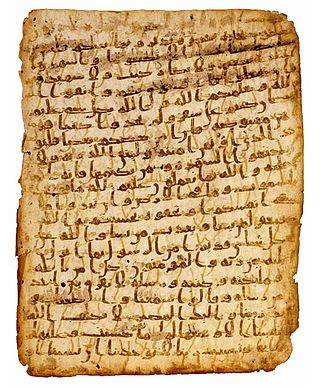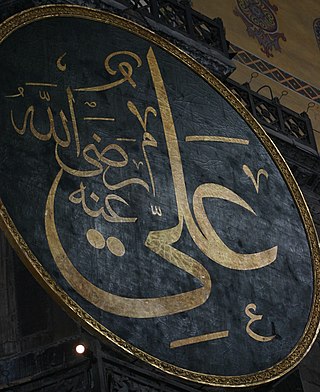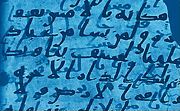Related Research Articles

The Quran, also romanized Qur'an or Koran, is the central religious text of Islam, believed by Muslims to be a revelation directly from God (Allāh). It is organized in 114 chapters which consist of individual verses. Besides its religious significance, it is widely regarded as the finest work in Arabic literature, and has significantly influenced the Arabic language. It is the object of a modern field of academic research known as Quranic studies.

The Zabur is, according to Islam, the holy book of Dawud, one of the holy books revealed by Allah before the Quran, alongside others such as the Tawrāh (Torah) and the Injīl (Gospel). Muslim tradition maintains that the Zabur mentioned in the Quran is the Psalms of Dawud.

The Samarkand Kufic Quran is a manuscript Quran, or mushaf, and is one of the 6 manuscripts which were penned under the caliphate of Uthman ibn Affan. They represented an effort to compile the Qur'an into a standardized version. It is not exactly known to which area the Samarkand codex was originally dispatched or whether it was Uthman's personal manuscript.
The history of the Quran, the holy book of Islam, is the timeline ranging from the inception of the Quran during the lifetime of Muhammad, to the emergence, transmission, and canonization of its written copies. The history of the Quran is a major focus in the field of Quranic studies.
In Islam, qirāʼa refers to the ways or fashions that the Quran, the holy book of Islam, is recited. More technically, the term designates the different linguistic, lexical, phonetic, morphological and syntactical forms permitted with reciting the Quran. Differences between qiraʼat include varying rules regarding the prolongation, intonation, and pronunciation of words, but also differences in stops, vowels, consonants, entire words and even different meanings.. However, the variations don't change the overall message or doctrinal meanings of the Qur'an, as the differences are often subtle and contextually equivalent.Qiraʼat also refers to the branch of Islamic studies that deals with these modes of recitation.

The Topkapı manuscript or Topkapı Quran is an early manuscript of the Quran dated to the middle 2nd century AH.
The Shia view of the Qur'an differs from the Sunni view, but the majority of both groups believe that the text is identical. While some Shia disputed the canonical validity of the Uthmanic codex, the Shia Imams always rejected the idea of alteration of Qur'an's text. Only seven Shia scholars have believed in omissions in the Uthmanic codex.

Islamic holy books are certain religious scriptures that are viewed by Muslims as having valid divine significance, in that they were authored by God (Allah) through a variety of prophets and messengers, including those who predate the Quran. Among the group of religious texts considered to be valid revelations, the three that are mentioned by name in the Quran are the Tawrat, received by prophets and messengers amongst the Israelites; the Zabur (Psalms), received by David; and the Injeel, received by Jesus. Additionally, the Quran mentions God's revealing of the Scrolls of Abraham and the Scrolls of Moses.
Tafsir Ayyashi is an Imami Shia exegesis of the Quran, written by Mohammad ibn Masoud Ayyashi also known as al-ʿAyyashi.

The Mushaf of Ali is a codex of the Quran that was collected by one of its first scribes, Ali ibn Abi Talib, the cousin and son-in-law of the Islamic prophet Muhammad. Ali is also recognized as the fourth Rashidun caliph and the first Shia imam. By some Shia accounts, the codex of Ali was rejected for official use after the death of Muhammad in 632 CE for political reasons. Some early Shia traditions also suggest differences with the official Uthmanid codex, though currently, the prevalent Shia view is that the recension of Ali matched the Uthmanid codex, save for the order of its content. The Twelver Shia believe that the codex of Ali is now in the possession of their last imam, Muhammad al-Mahdi, who would reveal the codex when he reappears at the end of time to eradicate injustice and evil.

The Birmingham Quran manuscript comprises two leaves of parchment from an early Quranic manuscript or muṣḥaf. In 2015, the manuscript, which is held by the University of Birmingham, was radiocarbon dated to between 568 and 645 AD. It is part of the Mingana Collection of Middle Eastern manuscripts, held by the university's Cadbury Research Library.

In Muslim tradition the Quran is the final revelation from God, Islam's divine text, delivered to the Islamic prophet Muhammad through the angel Jibril (Gabriel). Muhammad's revelations were said to have been recorded orally and in writing, through Muhammad and his followers up until his death in 632 CE. These revelations were then compiled by first caliph Abu Bakr and codified during the reign of the third caliph Uthman so that the standard codex edition of the Quran or Muṣḥaf was completed around 650 CE, according to Muslim scholars. This has been critiqued by some western scholarship, suggesting the Quran was canonized at a later date, based on the dating of classical Islamic narratives, i.e. hadiths, which were written 150–200 years after the death of Muhammad, and partly because of the textual variations present in the Sana'a manuscript. Muslim scholars who oppose the views of the Western revisionist theories regarding the historical origins of the Quran have described their theses as "untenable".
Abu Bakr ‘Aasim Ibn Abi al-Najud al-'Asadi, commonly known as ‘Aasim ibn Abi al-Najud, was, according to Islamic tradition, one of the seven primary transmitters of the Qira'at, or variant readings of the Qur'an. Of Arab origin, his method of reciting the Qur'an as transmitted by Hafs is the most common and popular way of reciting the holy book in the Muslim world in general.
Abu Sa'id Uthman Ibn Sa‘id al-Qutbi, better known as Warsh (110-197AH), was a significant figure in the history of Quranic recitation (qira'at), the canonical methods of reciting the Qur'an. Alongside Qalun, he was one of the two primary transmitters of the canonical reading method of Nafi‘ al-Madani. Together, their style is the most common form of Qur'anic recitation in the generality of African mosques outside of Egypt, and is also popular in Yemen and Darfur despite the rest of Sudan following the method of Hafs. The method of Warsh and his counterpart Qalun was also the most popular method of recitation in Al-Andalus. The majority of printed Mushafs today in North Africa and West Africa follow the reading of Warsh.
According to Islamic tradition, the Quran was revealed to the Islamic prophet Muhammad by the angel Gabriel (Jibril) in seven ahruf, translated variously as "styles", "ways", "forms" and "modes". Islamic scholars agree that the ahruf were styles used by the early Muslims to recite the Quran.

Quranic studies is the academic application of a diverse set of disciplines to study the Quran, drawing on methods including but not limited to ancient history, philology, textual criticism, lexicography, codicology, literary criticism, comparative religion, and historical criticism.
Canonized Islamic scripture are texts which Muslims believe were revealed by God through various prophets throughout humanity's history—specifically the Quran and Hadith. Muslims believe the Quran to be the final revelation of God to mankind, and a completion and confirmation of previous scriptures, revealed to Muhammad between 610 and 632 CE, and canonized around 650 by the Rashidun leader Uthman.
The Cairo edition, or the King Fu'ād Quran or the Azhar Quran, is an edition of the Quran printed by the Amiri Press in the Bulaq district of Cairo on July 10, 1924. It is the first printed Quran to be accepted by a Muslim authority, this authority being Al-Azhar.
Ibn Mas'ud's arrangement is a purported mushaf of the Quran that differs from the established mushaf of Uthman and is attributed to Abd Allah ibn Mas'ud, a companion of Muhammed.
References
- Shoemaker, Stephen J. (2022). Creating the Qur’an: A Historical-Critical Study. University of California Press. ISBN 978-0520389038.
- "Muṣḥaf". The Encyclopaedia of Islām: A Dictionary of the Geography, Ethnography and Biography of the Muhammadan Peoples, Volume 3, Part 2. E. J. Brill. 1970.
- Jeffery, Arthur, ed. (1937). Materials for the History of the Text of the Qur'an. E. J. Brill. ISBN 978-0520389038.